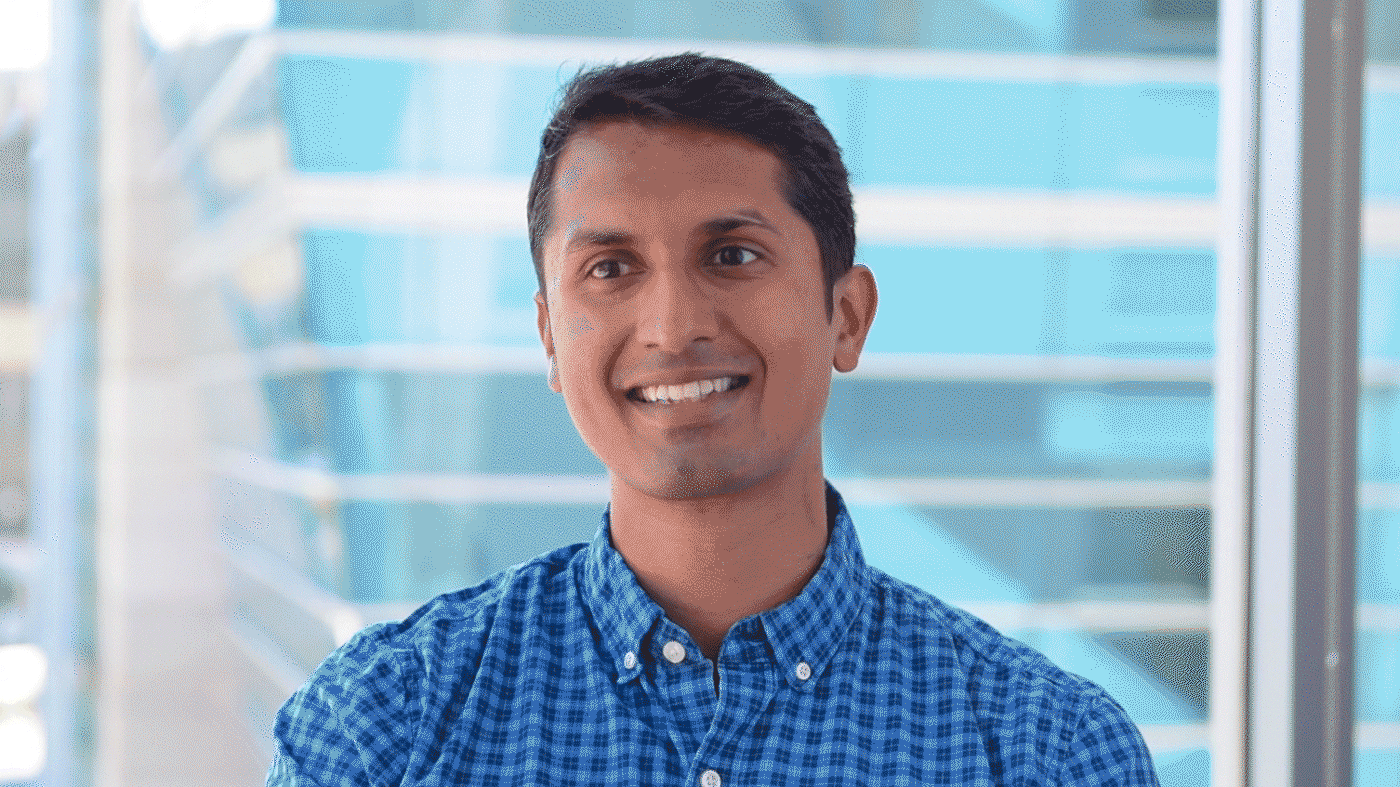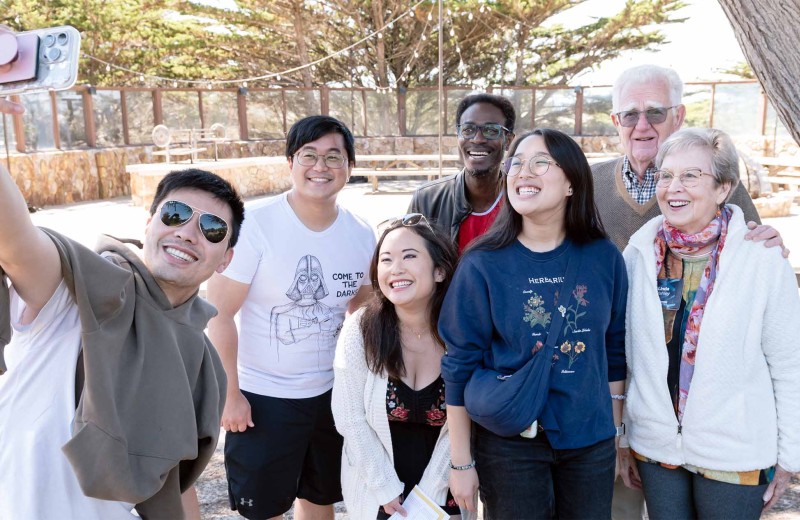Gladstone NOW: The Campaign Join Us on the Journey✕

Abdullah Syed discusses his love of reading and learning facts about animals, and what he loves most about working at Gladstone.
Abdullah Syed (he/him) is a postdoctoral scholar in the lab of Jennifer Doudna, where he’s working to better understand SARS-CoV-2, the virus that causes COVID-19.
Syed is interested in how viruses are able to deliver genetic information so efficiently to different cells in the body, which is a major challenge for treating a wide variety of infectious diseases. During his PhD studies in biomedical engineering at the University of Toronto in Canada, Syed worked to understand how to deliver nanoparticles to cancer cells in a tumor—a strategy that could help improve different forms of cancer treatment.
What brought you to Gladstone?
I had read Jennifer Doudna’s work on the mechanism of CRISPR-Cas9 and its application to genome editing. Genome editing is being used as a therapy for some genetic diseases, but the delivery of Cas9 is limited by the same problems we face with delivering nanoparticles. Jennifer and I both share an interest in figuring out how to improve delivery and also studying how viruses solve this problem.
I applied to her lab at the end of my PhD and she invited me to join her new lab at Gladstone where she wanted to focus on applying her basic research efforts to health and disease.
What do you like about Gladstone?
I love the people at Gladstone. Both the investigators and the trainees are exceptionally talented, and nearly everyone at Gladstone is pursuing fascinating and diverse research directions. This makes it really easy to take on bigger challenges in your own work, because you know you’ll be able to find someone who can help you with any given topic.
I also really like the operational staff at Gladstone, who enhance nearly every aspect of our work, including assisting with grants, intellectual property, facilities, and even helping us with writing and figure design. Of course, this also includes the Communications team, which has allowed our work to reach a broader audience than we could have on our own.
Were you interested in science as a child?
Yes, although my perception of science was different from what it is now. I loved to read about nature and geology and a variety of other topics. Throughout school, I enjoyed math and physics more than biology, though, and I had minimal exposure to experimentation until college. What hasn’t changed since the beginning is my curiosity—I still read broadly, including books on science, history, business, biographies of famous scientists and a few literary classics.
Why did you decide to go to graduate school?
In college, my program required us to take internships, and during that time, I worked in a company as well as a few scientific labs. It was obvious to me from my first internship that research would be my career. There were several reasons: the ability to work on problems that could make a big difference in the world; the opportunity to learn continuously; the fact that the work is creative and stimulating every single day; and the fact that I had freedom to control the direction of my work.
Can you describe your current research project?
I’m studying SARS-CoV-2, the virus that causes COVID-19. In particular, I’m trying to understand how the virus assembles in an infected cell and how it selectively finds and packages its own genomic RNA into particles, without packaging all the other RNA present in a normal cell.
We’ve found that newer variants have evolved to assemble more efficiently than previous ones through some mutations in a protein called the nucleocapsid, or N protein, and this seems to be part of the reason why COVID-19 has become more transmissible. I’m trying to understand how the assembly process works and why these mutations seem to improve it, because this may reveal weaknesses in the viral assembly process that we could potentially exploit to develop antivirals.
Similar work on HIV led to the development of a new class of drugs with extremely potent and broad activity, so we’re hoping that our work will also help us design better drugs to target coronaviruses in the future.
What or who influenced your decision to work in science?
I think I owe my interest in science mostly to my parents, who got me reading at a young age.
My decision to work in science also depended on me learning how to do science, and for that I’m grateful to all of my teachers and mentors. The biggest contribution was of course my PhD advisor, Warren Chan. I’m naturally curious, creative, and motivated, but I wouldn’t have learned how to communicate scientifically, manage people or projects, ask important questions, or a million other skills without his guidance. I hope I’ll have the opportunity to perfect these skills and eventually to pass them on to the next generation of scientists.
What do you do when you are not working?
Reading and fitness are my most consistent hobbies. I love learning new things and reading biographies. These days, most of my social time is spent with friends exploring or eating out in San Francisco.
If you could learn to do anything, what would it be?
Recently, I’ve been very impressed with ongoing work in artificial intelligence, protein structure prediction, and protein design. I think this work, along with directed evolution, could address some of the biggest problems we’re currently facing with delivering therapies to different parts of the body without triggering immune responses.
I’m inspired by how efficient viruses are at getting to different tissues in our body to cause disease, but viruses have had billions of years to perfect their function. If we could design proteins from scratch that can carry out specific functions in our body, we may be able to design the perfect medicines in a much quicker way.
What is your hidden talent?
I have an unlimited supply of bad puns and animal facts. For example, I recently learned that albatrosses spend about the same amount of energy flying as they do resting on the ground. They fly using this method called dynamic soaring, which is kind of like sailing in a boat—but in 3D. Eagles and turkeys can do static soaring, where they gain energy as long as the air is moving up, but with dynamic soaring, albatrosses can harvest wind energy as long as wind is moving slower near the Earth’s surface compared to at a higher altitude.
If you could meet any scientist from any point in time, who would it be and why?
It’s really hard to pick an individual scientist, but I would have loved to be around the phage group in the mid-1900s, when many of the core discoveries in molecular biology occurred.
It would be fascinating to see how scientists from disparate fields came together to try to understand a system so different from anything discovered until that point. Modern science tends to be highly collaborative, with scientists from many different disciplines playing important roles, but historically, there are only a few instances like this.
Want to Join the Team?
Our people are our most important asset. We offer a wide array of career opportunities both in our administrative offices and in our labs.
Explore CareersMeet Gladstone: Oscar Yip
Meet Gladstone: Oscar Yip
Oscar Yip is advancing Alzheimer’s research in Yadong Huang’s lab at Gladstone while drawing inspiration from his family, community, and his broader goal of helping patients.
Graduate Students and Postdocs Profile Alzheimer’s DiseaseFrom Mentorship to Legacy: Creating Opportunity for Early Career Scientists
From Mentorship to Legacy: Creating Opportunity for Early Career Scientists
Robert and Linda Mahley’s commitment to trainee development continues through Gladstone’s annual Career Advancement Awards.
Graduate Students and Postdocs HistoryWhen Brain Cells Talk: NOMIS-Gladstone Fellow Yuliya Voskobiynyk on Decoding Microglia’s Secret Signals
When Brain Cells Talk: NOMIS-Gladstone Fellow Yuliya Voskobiynyk on Decoding Microglia’s Secret Signals
NOMIS–Gladstone Fellow Yuliya Voskobiynyk, PhD, shares her journey from Ukraine to Gladstone and how her research on microglia could shed light on brain function and diseases like epilepsy and Alzheimer’s.
Graduate Students and Postdocs Profile Neurological Disease NOMIS



